The Best Shade Loving Climbing Plants for Your Garden
July 1st, 2021 | Categories
Many of us have a garden with at least some areas of shade. As more and more of us live in cities and suburban areas, it means even those of us with south-facing gardens can have shaded areas of the garden throughout the day, caused by buildings, structures and objects. Of course, north or east facing gardens will have more shade than sun over the entire day generally, and sun-loving plants will not thrive in such conditions. However, if you think this resigns you to a boring, lifeless, dull garden, bereft of colour, you do not need to fret. There are many plants than can tolerate shade, and many that prefer it, with some still producing lovely colourful flowers over the spring and summer months.
You can have a garden that is as inviting, interesting and as colourful as any, you just need to know the right plants for your specific situation. When it comes to shade-tolerant climbing plants, or climbers, specifically though, there’s still plenty of choice available. Many gardeners love climbing plants for their versatility, not only bringing impact and texture to gardens, but also softening hard edges or looks of sheds or fences, also acting as privacy walls, and if they produce flowers helping the local wildlife and pollinators.
Many people think that they can’t have lovely climbing plants because their garden is too shaded. Think again! There are so many climbing plants that do well in shade, more than you might think. This guide will help you to get all the information you need to know when it comes to choosing the best shade loving climbing plants for your garden. You’ll be able to start planning, picking and planting your way to a delightfully inviting space in no time.
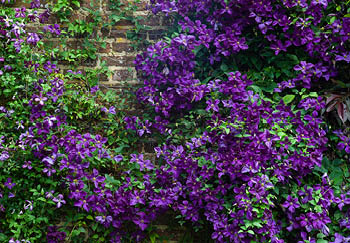
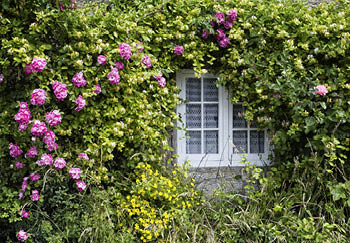
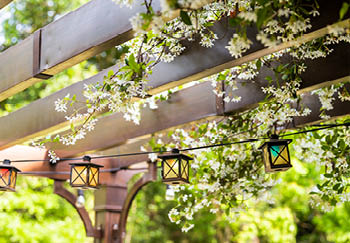
Understanding How Much Shade
The first thing you need to consider and understand is how much shade you have because there are a wide range of specific shade situations, and climbers respond differently to different levels of shade. Here are the main types of shade so you can figure out what you have, and it could be a mixture:
Light Shade
Open to the sky but screened from direct sunlight by something such as a structure like a wall or even trees.
Partial Shade
A spot that gets three to six hours of direct sunlight per day but is shaded for the rest of the time.
Dappled Shade
Dappled shade is classed as shade caused by something partially blocking sunlight such as a tree canopy. The light still shines through in a blotchy manner to a lesser degree. Akin to partial shade depending how much light makes it through.
Moderate Shade
A spot that gets two to three hours of direct sunlight per day.
Heavy Shade
A spot that gets less than two hours of direct sun per day, perhaps blocked by a building or dense tree cover.
Important note – if during these timeframes you get the sun during the midday hours, this actually applies more direct light, and might upgrade your shade category. For example, you might think you have moderate shade because you only get up to three hours of direct sunlike per day, but if these hours of sun occur around midday when the sun is at its highest, then you would say it’s actually a partially shaded area.
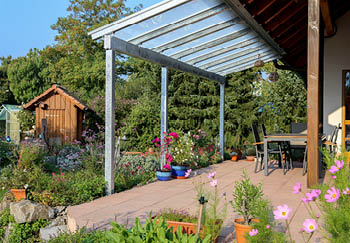
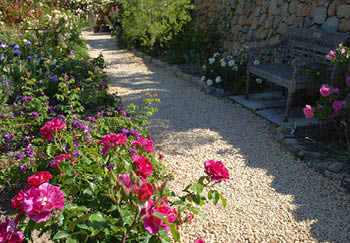
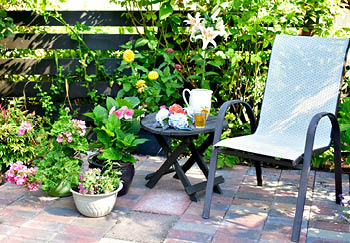
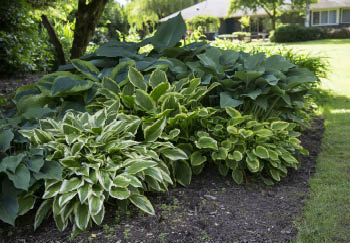
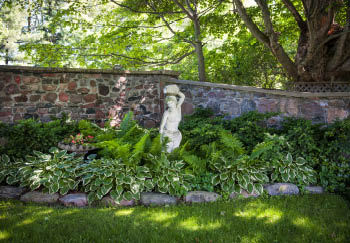
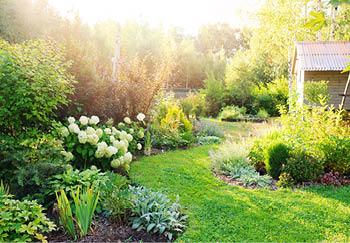
Consider Your Soil Too
It’s important to consider your soil in the shaded areas too. Shaded areas are known to come with very damp and soggy, or very dry soil. If your soil happens to be dry, then the best thing for you to do prior to planting anything is to improve it. You can do this by digging it up, and then digging in plenty of good compost, as well a drainage improver like Perlite. This is even more essential if you have a heavy clay soil.
Afterwards, it’s also advisable to apply an organic mulch over the top of the planting area and around the base of your climbers each year in spring. This will break down and improve the soil further. If it’s the opposite and happens to be wet, then you do exactly the same thing. Though perhaps more emphasis will have to be placed on the drainage improver in wet cases. Sorted.
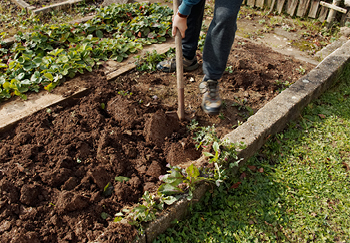
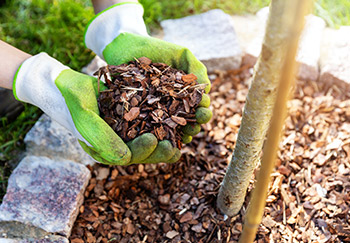
Shade Loving Climbing Plant Ideas in Your Garden
Now you know the different shade and soil considerations it’s time for the good part of this guide: the plant ideas! You might be surprised at just now much choice you have available.

Shade Tolerant Climbers
These shade tolerant climbers can be planted once and will come back with lovely flowers year after year so long as you look after them. So, here’s a plethora of options for you to consider:
Climbing Roses
Many climbing roses are well suited for growing in light to moderate levels of shade but are not suited to heavy shade. Roses are a brilliant way of adding colour and interest to a forgotten part of the garden and due to their symbolism evoke so many positive feelings in people.
Climbing Hydrangea
Like climbing roses there are many varieties of climbing hydrangeas that do well in shade too. Climbing hydrangeas are a great plant for shade adding colour and interest plus they even self-cling. Once they get going, they are quite a vigorous grower.
Ivy
All varieties of ivy are great climbing plants for shade, even in heavy shade. They won’t produce a flower, but they are a good grower and will cover a significant area, which is good if privacy is your main motivator. There are many different types of ivy, why not try a mixture of solid colour and the variegated varieties for that bit of extra interest.
Trachelospermum Star Jasmine
Star Jasmine is a great choice of shade tolerant climber. While it prefers a sunny spot, it will do well up to moderate shade. It is a great choice of climber because it is also famously fragrant. The petite little flowers have an interesting five-point shape so giving it its name. Yellow and Winter Jasmine are also great choices.
Honeysuckle
Like star jasmine honeysuckle has a lovely floral scent and can even flower multiple times throughout the spring and summer. Best placed up to moderate shade they will also self-cling and grow up most surfaces, but they will need help growing up walls.
Clematis
Clematis are great climbers for shady gardens. They are one of the fastest growing climbing plants around giving a burst of colour with their masses of flowers in a variety of shapes and colours. Some clematis even grow in heavily shaded areas.
Virginia Creeper (American Ivy)
Be warned, this is a particularly rampant climber. But it is very nice too hence its popularity. Typically, it is used on walls of large houses. It is shade tolerant up to moderate levels of shade. In summer it will bear little flowers followed by small blackberries in autumn. Its foliage will change from green to shades of red and orange before finally falling. A great choice if you have the space and want a real show of colour.
Chile Lantern Tree
A great option for creating interest, and even a talking-point in the garden, the Chile Lantern Tree is so called for the almost lantern-like crimson flowers it produces in the warmer months, standing out amongst dark green foliage. Grows well up to partial shade.
Japanese Quince ‘Pink Lady’
More of a climbing shrub, the pink lady produces small cup shaped pink flowers followed by small apple-like fruits that change in colour from green to yellow. Good for light to moderate shade.
Celastrus orbiculatus (Oriental Bittersweet)
This is a lovely and colourful fast-growing climber with stems that bear clusters of greenish flowers followed by attractive little berries. The leaves then become yellow in autumn. Best for light to dappled shade.

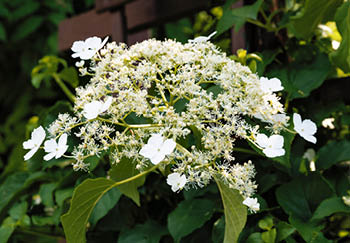
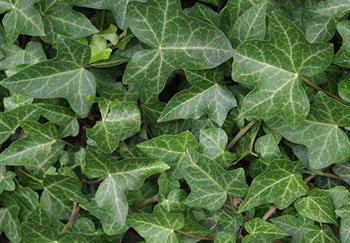
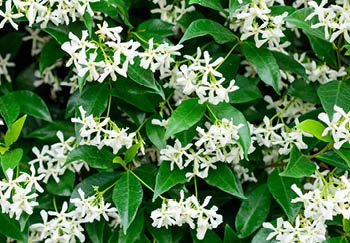


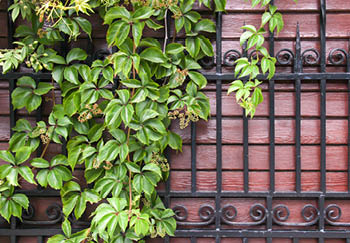
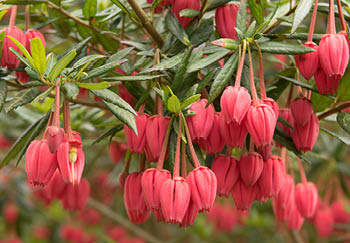

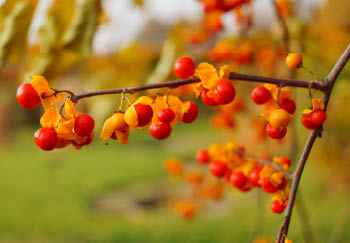
Other Things to Consider
When choosing climbers for shade, you also want to consider the hows and whys that go into constructing an impactful display. For instance, you don’t want too many dark greens on the fence in an already shaded area, because it will make it look even gloomier. However, use them instead as background and texture. Then get other non-climbing plants with more impact and colour in front to make them really pop. Bright and bold colours will work best if you want that maximum impact. Incorporating different leaf shapes such as ferns, hostas and grasses with your flowering plants will help to create texture and interest too.
Another thing to note is for any plant that flowers; the heavier the shade the less likely they’ll flower, or not flower as much as in lighter shaded spots. Ultimately all plants need levels of sunlight for the energy to grow and flower (if they do). It’s just something you need to keep in mind. One last point, consider how much attention they will need. Some climbers are vigorous meaning they will require a lot of pruning and attention to keep in check. If you don’t have the time or want something low maintenance, then be sure to check before you buy.

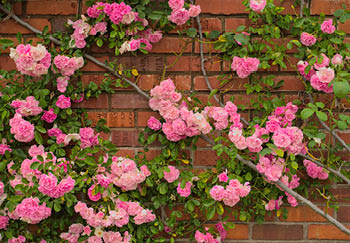
Climbing Plants to Liven Your Shaded Garden
There you have it. Shade tolerant climbing plants do exist and there’s actually quite a lot of choice. Now that you understand the different types of shade and soil, and which climbers you can grow, you can add that colour and vibrancy to an area that otherwise might have gone unloved. Take a look at our other guide here for more ideas on shade loving flowers and shrubs you could combine with your climbers to create a really stunning area in your garden, despite the shade.
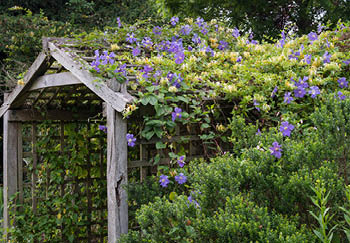
Useful Links
- Shop Online for Plants
- How to Start Gardening (Article)
- What to Plant in My Garden (Article)
- How to Plant a Patio Climbing Rose (Article)
- Choosing the Best Shade Loving Plants for Your Garden (Article)
- Create a Summer Flower Border (Article)
- Three Seasonal Tips for Healthy Hydrangeas (Article)






